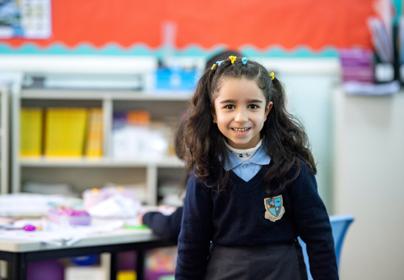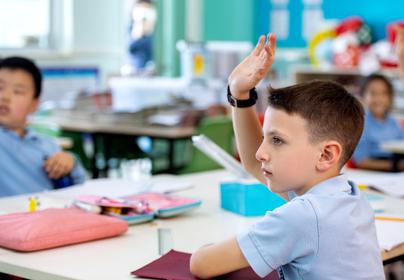本周,上海不列颠英国国际学校幼教部的孩子们沉浸在了激动人心的STEAM世界——科学、技术、工程、艺术和数学之中。STEAM教育在我们上海不列颠英国国际学校的课程中扮演着至关重要的角色,它通过动手探索和有目的的游戏,培养孩子们的好奇心、创造力和批判性思维。
在早期教育阶段,STEAM并非作为独立学科来教授,而是自然地融入孩子们的日常体验中。通过搭建、制作、实验和发现,我们的小学习者们正在奠定科学探究的基石、形成早期的设计思维,并培养对终身学习的热爱。这种综合教学方式与EYFS框架和"好奇心教学法"完美契合,两者都强调通过好奇心、探索和创造力来学习。
在这一周里,孩子们忙于设计、构建、测试和改进。他们探索了物体如何组合、平衡和运动——使用天然和人造材料将他们的想法变为现实。从桥梁、塔楼到小船和车辆,每一件作品都始于一个问题:"如果……会怎样?"或"我们怎样才能让它工作?"孩子们随后运用解决问题和批判性思维的能力来调整他们的想法,并在实践中检验它们,观察接下来会发生什么。
这些丰富的经历让孩子们有机会观察因果关系,学习协作,并在事情未按计划发展时学会坚持。每一次实验和每一件建构作品都成为一个发现的时刻,增强了他们对世界的理解以及对自己能力的信心。

STEAM中的艺术也是本周的核心部分,它让孩子们能够以视觉和创意的方式表达自己的想法。无论是绘制设计草图、描绘富有想象力的蓝图,还是装饰他们的模型,艺术都鼓励他们看到创造力与创新之间的联系——这是早期工程和科学思维的重要组成部分。
早期教育阶段的STEAM学习与EYFS课程的关键领域紧密相连。它通过孩子们讨论和解释自己的想法来培养沟通和语言能力;通过搭建、连接和操作材料促进"身体发展";并在他们探索事物工作原理时深化"理解世界"。同时,它也滋养着"个人、社会和情感发展",孩子们学会轮流、分享想法并共同庆祝成功。
STEAM周让我们感受到发现的乐趣和好奇心的力量。当孩子们被给予时间和空间去探索、实验和创造时,他们不仅了解了周围的世界——更认识到自己是具有能力的思考者和问题解决者。这些经历能够培养自信、韧性和想象力,帮助我们最小的学习者认识到他们的想法很重要,并且他们也可以成为未来的发明家、艺术家和科学家。

在中班,孩子们从奥利弗·杰弗斯的故事《卡住了》中获得了灵感。他们被“所有东西都卡在树上”的故事深深吸引,并以此为灵感,开启了自主学习的旅程。结合数学课上对二维形状的学习,孩子们设计并制作了自己的风筝。他们仔细选择形状,测量结构,并探索如何将材料连接在一起。在用彩色丝带和线装饰好风筝后,孩子们把它们带到户外,测试它们能否飞起来。
有些风筝高高飞入空中,而有些则需要一些调整——这引发了关于平衡、风和设计的丰富对话。通过这次体验,孩子们发展了关键的STEAM技能,如解决问题、观察力和毅力。他们协同合作,练习了精细动作控制,并加深了对形状、测量和材料的理解。这个项目巧妙地将EYFS框架下的读写、数学和科学连接在一起,展示了寓教于乐如何同时培养知识和自信。
与此同时,小班的孩子们度过了兴奋的一周,因为天气转凉,给我们的环境带来了各种季节性的变化。孩子们通过故事、讨论和户外探索来感受秋天的奇妙——他们注意到树叶变成了美丽的颜色,种子和七叶树果实纷纷飘落,空气也变得凉爽起来。
作为STEAM周的一部分,孩子们还愉快地唱起了活泼的《叮当稻草人》歌曲,并用木棍、干草以及混合的自然和回收材料制作了自己的稻草人。看到孩子们在搭建、装饰并个性化自己的稻草人,创造力得以充分发挥,令人欣喜。这些经历支撑了早期的工程和设计技能,同时鼓励孩子们思考思考如何将各种材料组合起来,实现不同的用途。
在托班,孩子们一直在探索南瓜奇妙的生命周期,深入了解种子如何生长成果实和蔬菜。他们的主要活动包括挖出南瓜内部,讨论南瓜肉的质地——感受它黏糊糊、滑溜溜的!孩子们小心翼翼地取出自己的种子,谈论南瓜皮的颜色、形状和质地。
我们本周的书籍《种一个南瓜》很好地支持了这项探索,帮助孩子们理解南瓜始于微小的种子,然后长成藤蔓、花朵,最终成为我们在万圣节前后看到的巨大、凹凸不平的南瓜。每个人都喜欢一起调查、谈论和探索——我们都为下周即将到来的"南瓜嘉年华"做准备,为此感到兴奋不已。
在整个幼教部,STEAM周是一场对好奇心、创造力和发现的庆祝。无论是制作风筝、手工稻草人,还是探索南瓜,孩子们都在发展关键的基础技能——从沟通和解决问题到科学思维和想象力。通过游戏和探索,他们不仅在认识世界,更在学习如何对世界进行思考、质疑和好奇。




